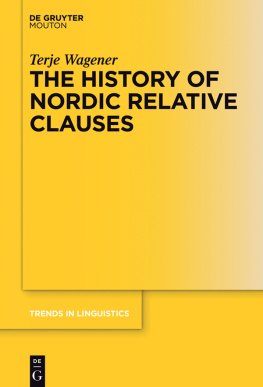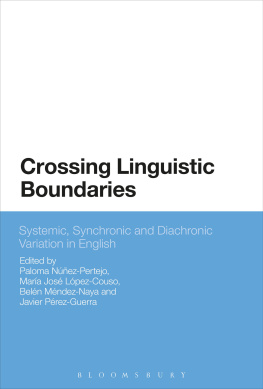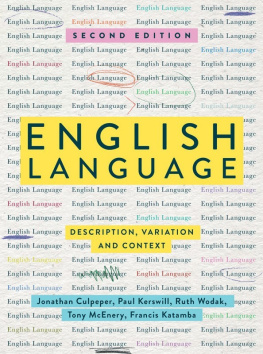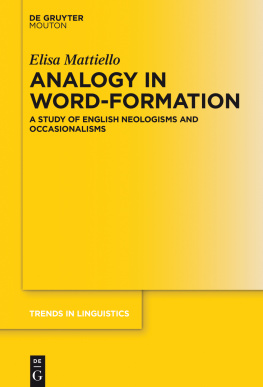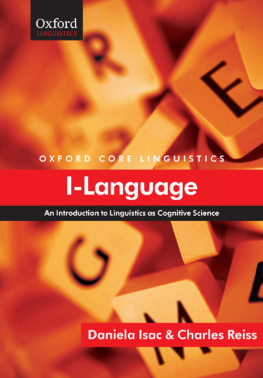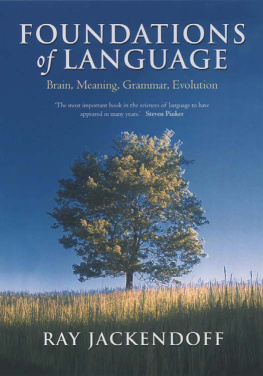Contents
Guide

Terje Wagener
The History of Nordic Relative Clauses
Trends in Linguistics Studies and Monographs

Editor
Volker Gast
Editorial Board
Walter Bisang
Jan Terje Faarlund
Hans Henrich Hock
Natalia Levshina
Heiko Narrog
Matthias Schlesewsky
Amir Zeldes
Niina Ning Zhang
Editor responsible for this volume
Volker Gast
Volume 304

ISBN 978-3-11-049557-7
e-ISBN (PDF) 978-3-11-049653-6
e-ISBN (EPUB) 978-3-11-049295-8
ISSN 1861-4302
Library of Congress Cataloging-in-Publication Data
A CIP catalog record for this book has been applied for at the Library of Congress.
Bibliographic information published by the Deutsche Nationalbibliothek
The Deutsche Nationalbibliothek lists this publication in the Deutsche Nationalbibliografie; detailed bibliographic data are available on the Internet at http://dnb.dnb.de.
2017 Walter de Gruyter GmbH, Berlin/Boston
www.degruyter.com
Acknowledgements
This book is a reworked version of my PhD-dissertation from 2014, The history of Norwegian relative clauses. I would thus like to thank Prof. Jan Terje Faarlund at the University of Oslo, who was my supervisor. He was and remains a great pleasure to discuss linguistics (and politics) with. Second, I would like to send my thanks to Prof. Endre Mrck at the University of Troms, who did a superb job supervising my MA-thesis back in the days.
Some of the individuals that have held out with me throughout the years (in no particular order): Olka Kolenda, Ratcliffe, Nelson and my mother.
I dedicate this book with love, affection and gratefulness to Ania Duckie Kirstein.
Abbreviations of linguistic terms
Examples have been provided with a word-for-word gloss as well as an idiomatic translation, except when the gloss and the translation are identical. English and the Scandinavian languages are very closely related. Therefore, I have not found it necessary to explicitly mark all the morphosyntactic features of each gloss. Case is marked only when it is relevant for the discussion (for instance, in explaining case attraction). Relative complementizers are invariably marked COMP. The determiner s and its cognates and descendants have also been found worthy of explicit marking, since this element plays a key role in Nordic relative clauses from the earliest days. I have chosen three different annotations for this element: S for Old Norse and Old Swedish s ; THEN for Middle Norwegian and Middle Danish (and partially also Late Old Swedish) then/thn and, finally, DEN for the Modern Scandinavian languages.
| ACC | accusative |
| ADJ.STRONG | adjective carrying the strong inflection |
| ADJ.WEAK | adjective carrying the weak inflection |
| ART | article |
| COMP | (relative) complementizer |
| DAT | dative |
| DEF | definite |
| DEM | demonstrative |
| DEN | the Modern Scandinavian determiner den |
| EXPL | expletive |
| FEM | feminine |
| GEN | genitive |
| INDEF | indefinite |
| LOC | locational |
| MASC | masculine |
| N | noun |
| NP | noun phrase |
| NEUT | neuter |
| NOM | nominative |
| NOM.COMP | nominal complementizer |
| PERS | person |
| PL | plural |
| PP | prepositional phrase |
| PRON | pronoun |
| PROX | proximal |
| Q | quantifier |
| REFL | reflexive |
| RELPRON | relative pronoun |
| RESUMP | resumptive pronoun |
| RECAP | recapitulating pronoun |
| R-COMP | R-compound |
| S | the Old Norse determiner s |
| SG | singular |
| TEMP.ADV | temporal adverb |
| TEMP.COMP | temporal complementizer |
| THEN | the Middle Norwegian determiner then , the Middle Danish determiner n/thn or the Old Swedish determiner n/thn |
| WPRON | w-pronoun |
Abbreviations of sources
| BON | I det mest upolerede bondesprog |
| BORG | The Borgarting code |
| DN | Diplomatarium norvegicum |
| EID | The Eidsivating code |
| HOM | Gamalnorsk homiliebok |
| JYS | Jyske lov |
| KS | Konungs skuggsj |
| LAX | Laxdla saga |
| MOR | Den fyrste morgonblnen |
| OLA | lfs saga hins helga |
| SJ | Eriks sllandske lov |
Languages and the periods they cover
When the distinction between younger and older Middle Danish and Old Swedish is not relevant, they are referred to simply as Middle Danish (MLD) and Old Swedish (OSW). I use Early Nordic as a term to cover the Nordic languages in their Old and Middle stages in general. Moreover, in the early period it makes sense to distinguish between a West-Nordic and an East-Nordic dialect (cf. Haugen 1976:199). West-Nordic (i.e. Old Norwegian and Old Icelandic) corresponds to Old Norse, so I will stick to the latter term. But I will use the term East-Nordic to refer to Swedish and Danish, in particular in reference to the old and middle stages of those languages (when the east/west-division is important).
Finally, I have found it difficult to avoid the term Scandinavian altogether, especially when referring to the modern languages. I use it here in the sense of Mainland-Scandinavian, i.e. not including Icelandic and Faroese. With regard to the modern languages, the differences between Danish, Swedish and Norwegian on the one hand and Icelandic and Faroese on the other are so significant that a term referring only to the former is called for.
| AN | Ancient Nordic (ca. 200ca. 800) |
| ON | Old Norse (ca 800ca. 1350) |
| MLN | Middle Norwegian (ca. 1350ca. 1525) |
| MNO | Modern Norwegian (from 1525 onwards. The period from 1525 until ca. 1800 will be referred to as Early MNO.) |
| EOSW | Early Old Swedish (12251375) |
| LOSW | Late Old Swedish (13751526) |
| OMLD | Old Middle Danish (11001350) |
| YMLD | Younger Middle Danish (13501525) |
List of Tables
| Page 59 | Table 1: | Antecedents of nominal RCs in lfs saga hins Helga |
| Page 60 | Table 2: | Antecedents of nominal RCs in lfs saga hins Helga which feature a noun but not s |
| Page 60 | Table 3: | Antecedents of temporal RCs in lfs saga hins Helga (with examples) |
| Page 102 | Table 4: | S -insertion in relative complexes where the antecedent does not include a noun |
| Page 115 | Table 5: | Antecedents of nominal RCs in Eriks sllandske lov |

